Landings
The Landings section allows administrators to manage, upload, and organize custom landing pages. By providing the HTML code of your site, you can link each landing directly to specific activations or events, ensuring seamless integration and a consistent user experience across the platform.
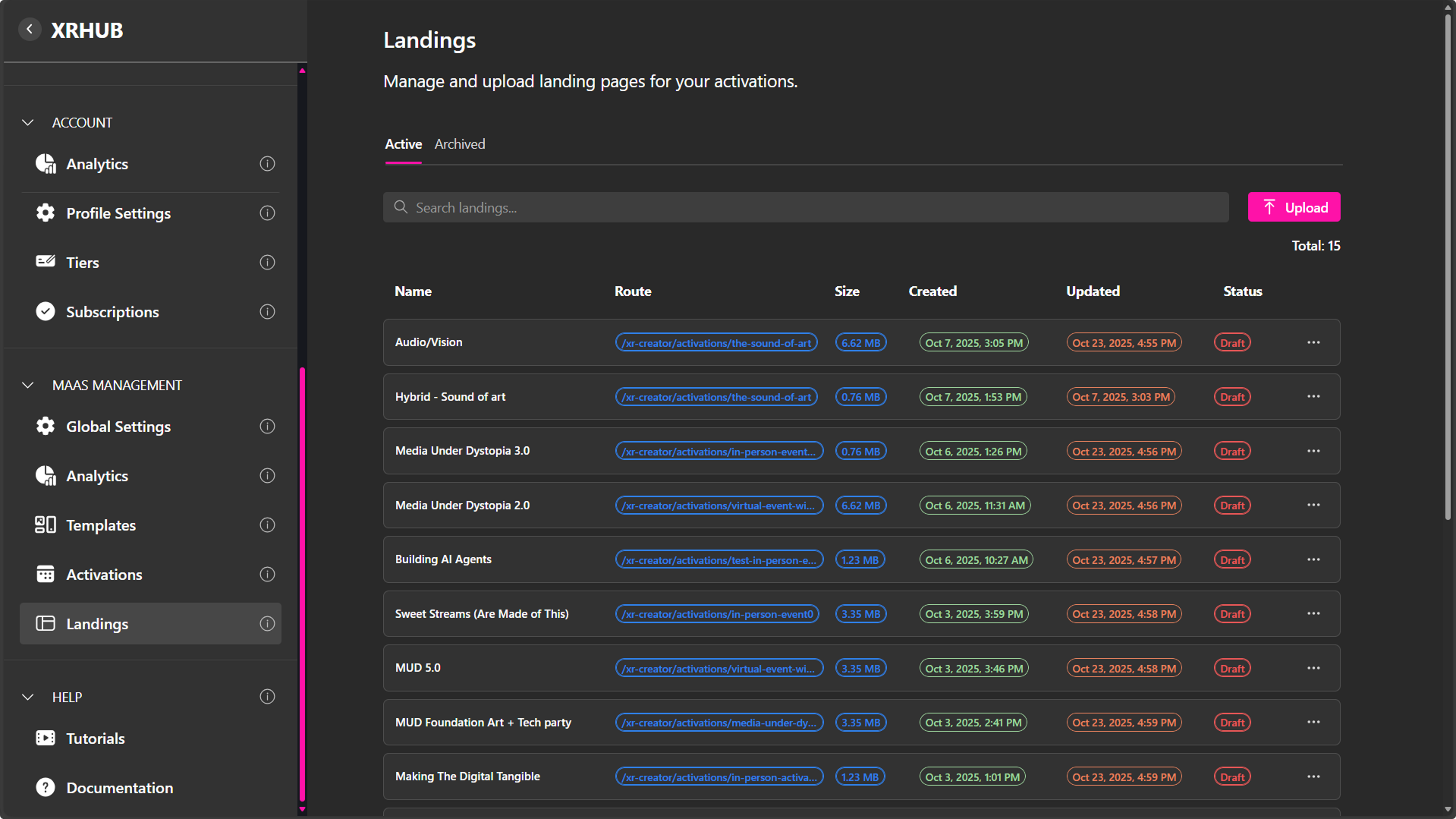
The Landings Dashboard provides a centralized view of all active and archived landing pages associated with platform activations. Each entry displays key information such as the page name, route, file size, creation and update timestamps, and publication status.
At the top of the page, you’ll find:
- Active / Archived Tabs – Switch between currently used landing pages and archived ones.
- Search Bar – Filter pages by name or keyword.
- Upload Button – Add a new landing page to the system.
- Total Counter – Displays the number of landing pages currently available (e.g., “Total: 15”).
Landing Management Overview
Each row in the dashboard corresponds to a single landing page and includes the following information:
| Column | Description |
|---|---|
| Name | The title of the landing page (e.g., Audio/Vision, Media Under Dystopia 3.0). |
| Route | The unique URL path connecting the landing page to its activation (e.g., /xr-creator/activations/the-sound-of-art). |
| Size | File size of the landing page package in megabytes (MB). |
| Created | Date and time the landing page was first uploaded. |
| Updated | Timestamp of the last modification. |
| Status | Indicates the publication state (e.g., Draft or Published). |
Uploading a Landing Page
Clicking the Upload button opens the Upload New Landing window, where you can add and configure a new landing page.
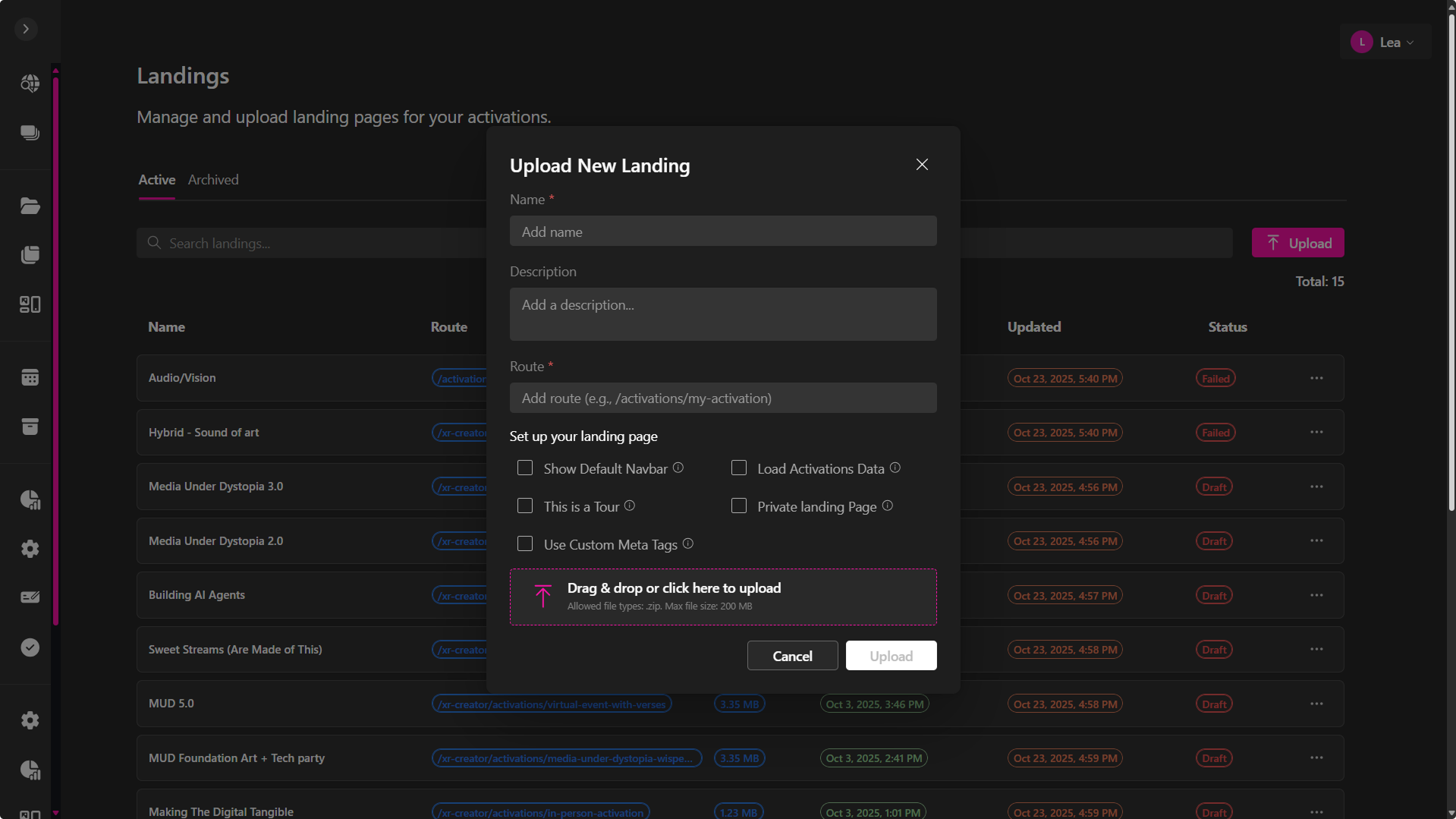
Upload Fields
| Field | Description |
|---|---|
| Name | The title of your landing page. This appears in the dashboard and identifies the page in the system. |
| Description | A short summary describing the landing page or its purpose (optional). |
| Route | The URL path that defines where the landing page will be accessible (e.g., /activations/my-activation). |
File Upload
At the bottom of the form, upload your landing package:
- Drag and drop your
.zipfile into the upload area or click to browse manually. - Allowed file type:
.zip - Maximum file size: 200 MB
Important:
Your .zip file must follow the correct structure for the system to recognize and deploy the landing page properly.
- The index.html file should be placed at the root level of the ZIP (not inside any subfolder).
- Supporting directories such as
/css,/js,/fonts, and/imagesshould be included alongside the index file.
Example structure:
/fonts
/images
/js
401.html
404.html
index.html
Once uploaded, the landing will appear in the Active list with a Draft status until you publish it.
Landing Management Options
Each landing entry includes a context menu accessible through the three-dot (⋮) icon.
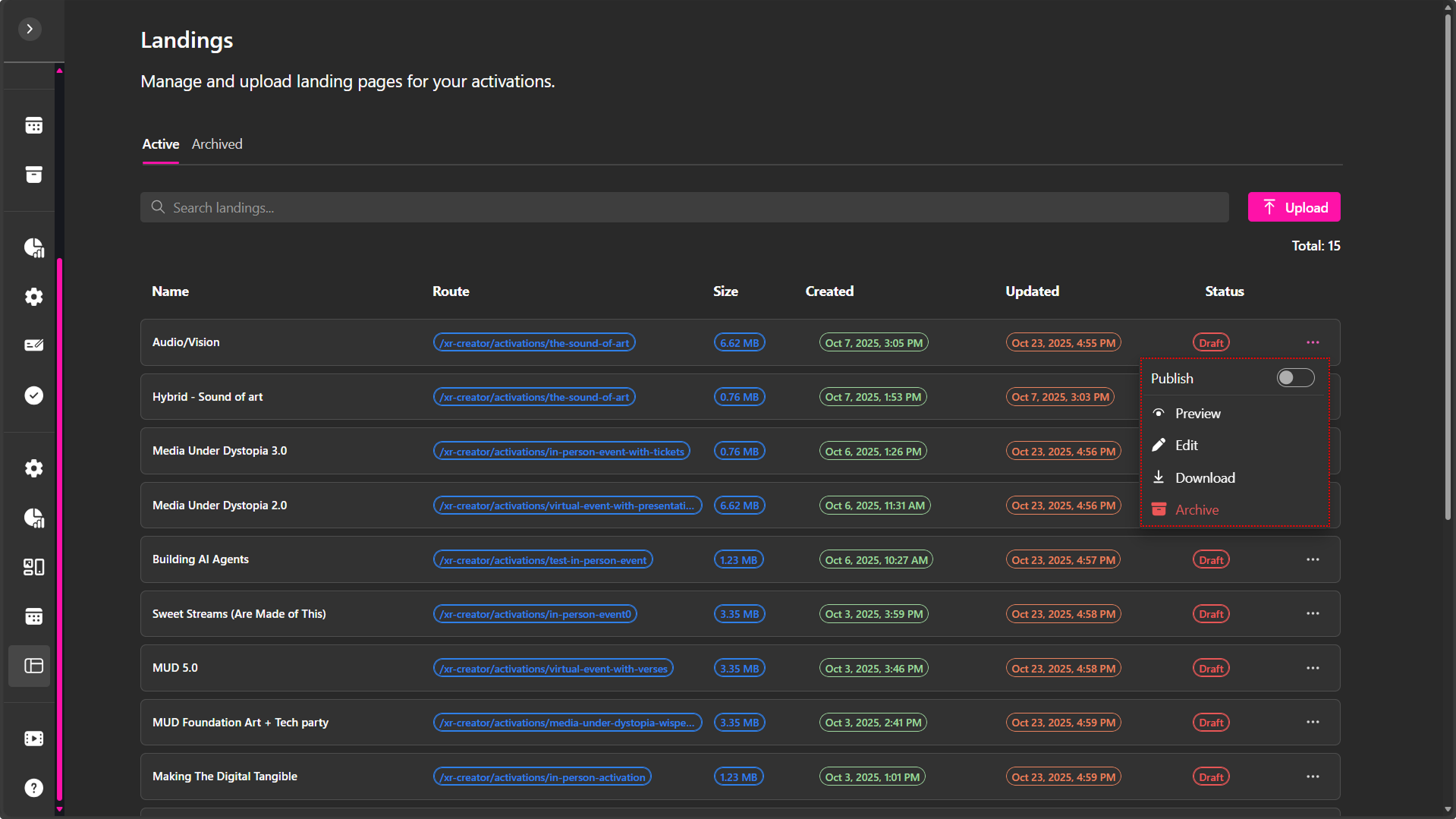
From this menu, administrators can manage, preview, or publish pages as needed.
Publish
Toggle to make the landing page publicly accessible. When published, the landing page becomes available at its designated route and linked activation.
Preview
Opens a preview of the landing page in a new window, allowing you to review its layout, media, and content before publishing.
Edit
Opens the landing page for modification. Use this option to update content, replace assets, or revise text before republishing.
Download
Downloads the landing page package (HTML/CSS/JS files) for local editing or backup.
Archive
Moves the landing page to the Archived tab. This helps declutter the active list without deleting the page permanently.
Active and Archived Tabs
- Active Tab – Displays all landing pages currently available for use or under development.
- Archived Tab – Contains older or unused landing pages that are stored for reference or future reactivation.
Administrators can switch between these tabs at any time to review or restore archived content.
Connecting Landings to Activations
Each landing page can be directly associated with a specific activation or event route.
This ensures users are presented with a branded landing experience before entering an XR environment.
Typical use cases include:
- Event registration or RSVP forms
- Pre-show information pages
- Sponsor or partner showcases
- Interactive previews or countdown pages
To connect a landing page to an activation, ensure that the route path matches the activation’s defined URL in the system.
Custom Classes for Custom Landings
Custom classes can be added to your HTML elements to enable specific interactive features, such as RSVP buttons, activation timers, and dynamic program sections.
RSVP Button
To enable the RSVP button for activations and allow users to confirm their attendance, add the following class to your RSVP button element:
rsvp-button
Example:
<button class="rsvp-button">RSVP Now</button>
Ticket Button
To enable ticket access for in-person activations, add the class:
ticket-button
This should be applied to the button that users click to view their activation tickets.
How to Enable a Timer in Activation Landings
Add the following required classes to your HTML structure to display a countdown timer:
timer
days
hours
minutes
seconds
Example:
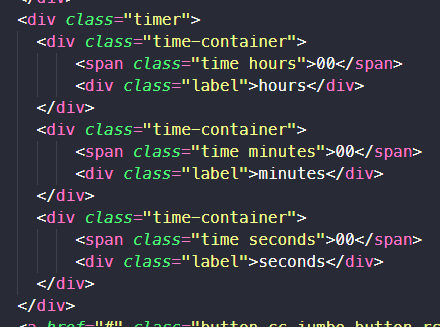
These elements must exist in the layout so the system can inject the remaining time dynamically.
How to Enable Dynamic Programs in Custom Landing Pages
To enable dynamic activation programs, specific classes must be added in an organized hierarchy. These allow the system to recognize and populate activation schedule data correctly.
You only need to create one calendar day and one presentation as a base structure — the platform will replicate it dynamically.
Required Classes:
program
program-day
program-day-text
program-presentations
program-presentations-list
program-presentation
program-presentation-time
program-presentation-image
program-presentation-name
program-presentation-description
program-presentation-button
program-presentation-presenters-list
program-presentation-presenter
program-presentation-presenter-name
program-presentation-presenter-image
program-presentation-presenter-bio
Example:
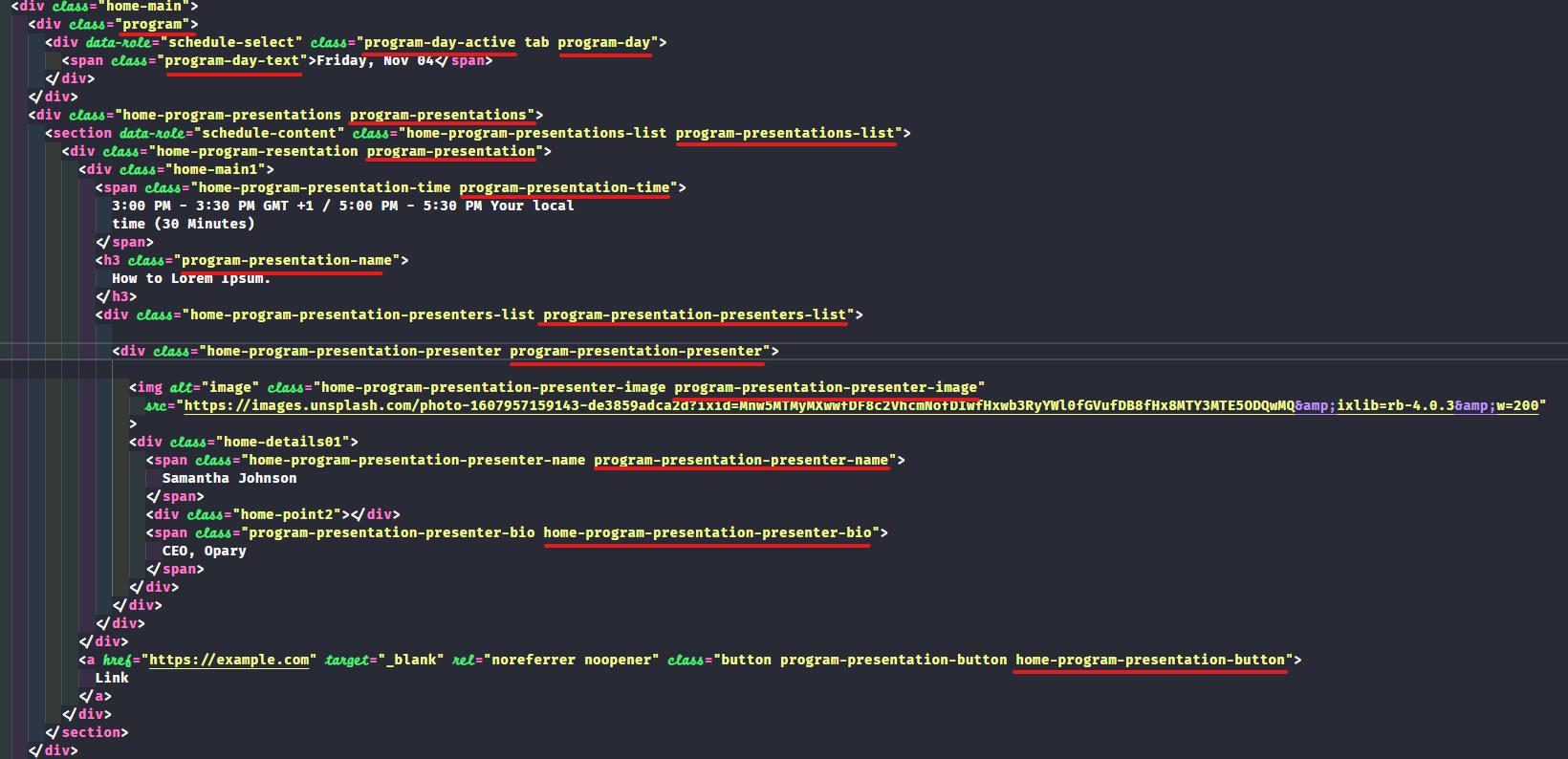
These classes ensure that all schedule elements (days, presentations, speakers, and times) are properly displayed and dynamically updated.
💡 Pro Tip:
Before uploading, test your landing locally to confirm that all asset paths (CSS, JS, images) load correctly and that custom classes behave as expected. This prevents missing styles, broken layouts, or unresponsive buttons after deployment.
Notes
- Only administrators or authorized creators can upload and publish landing pages.
- Archiving does not delete content — archived landings can be restored anytime.
- Ensure each landing page route is unique to prevent conflicts with activations.
- Preview pages before publishing to confirm layout and functionality.
- Use consistent naming conventions for easy identification and organization.